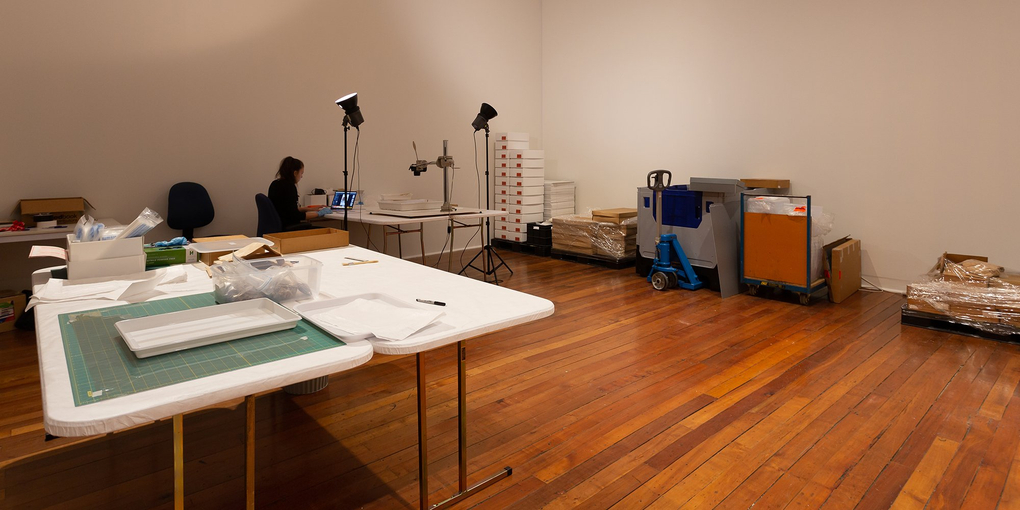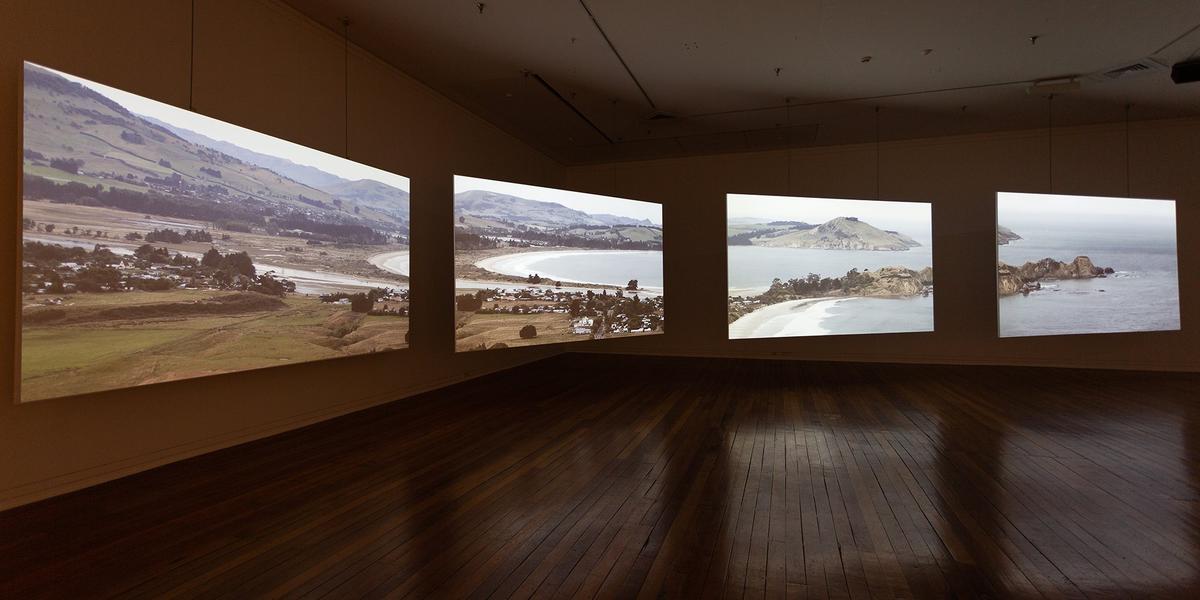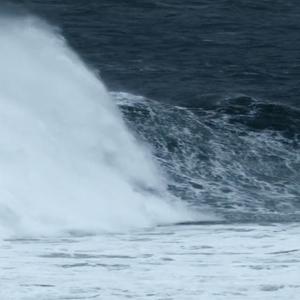A great deal of New Zealand's archeological heritage is not beneath the soil, but instead is buried deep in the stores of museums and universities, waiting to be revisited.
What immediately catches your eye when you enter the darkened space dedicated to this exhibition is four large screens, suspended in mid-air and arrowing towards one corner of the room like birds flying in formation. The screens themselves are showing a 76 minute long, 4-channel video on continuous loop, from what continues to be a work-in-progress.
Re-edited and now expanded, this is the second iteration of this video work, which was presented as Coastal Flows/Coastal Incursions: In the Light of Time at ST PAUL St Gallery at the Auckland University of Technology in 2017. That version was 32 minutes and 47 seconds long, and consisted partly of footage from a journey film-maker, photographer and artist Alex Monteith made on a small boat around Tamatea (Dusky Sound) in Fiordland in 2014, and partly of footage shot at the Southland Museum and Art Gallery Niho o Te Taniwha in 2016. The latter footage showed gallery conservation staff, together with Ngāi Tahu archeologists Atholl Anderson and Gerard O'Regan, as well as other Ngāi Tahu iwi representatives, examining and discussing artefacts nestled in white foam trays in boxes on long tables. The Auckland exhibition had attendant performance aspects: a continuation of the process of examining, classifying and cataloguing of archeological artefacts, by on-site conservators.
Alex Monteith's exhibition at the Dunedin Public Art Gallery, building on the previous one, requires similar unpacking and discussion in order to be made sense of. It is a bricolage: a multi-layered assemblage exploring bicultural tensions and relationships within a specific context that needs some background knowledge. The context is the archeological material, both pre-European contact and early colonial, collected from multiple sites—mostly rock cave shelters—in Te Mimi o Tū Te Rakiwhānoa (the Fiordland coastal and marine area) by Otago University anthropology graduate Peter Coutts between 1968 and 1972. Coutts was undertaking his PhD in archeology at that time, but had had little practical archeological experience. His project was ambitious and wide-ranging, and his excavations of 12 sites in total tended to be conducted quickly with the excavation pits abandoned and left open to the weather. His methodology back then was emblematic of the conquest of nature approach, of the colonising gaze, and of a cavalier approach to cultural differences.
Sometime after 1972 it is surmised that the excavated material was transferred out of cursorily catalogued storage; and most of it—around 360 boxes—went to the Southland Museum, and the remainder, around 80 boxes went to the Otago Museum. Coutts himself later left for Australia, where he became Director of the Archeological Aboriginal Artefacts office, before eventually moving elsewhere and disappearing off the record.
Coutts' methodology back then was emblematic of the conquest of nature approach, of the colonising gaze, and of a cavalier approach to cultural differences.
Alex Monteith was drawn to investigating the fate of the materials recovered by Coutts, its dormancy within a museological setting, by a chance conversation with a former Fiordland forestry worker in 2012. One of her investigations turned up photocopies of Peter Coutts' archeological field notes from 1965-1972 towards his PhD thesis, which was entitled The Emergence of the Foveaux Strait Māori from Prehistory: a Study of Culture Contact. These are held in the Hocken Collections Uare Taoka o Hākena. Between May and June 2018, the photocopies were displayed at the Hocken Gallery as part of The Order of Things, a group exhibition on systems of knowledge classification, digital technologies and mātauranga Māori, or Māori knowledge systems. Monteith, in collaboration with Ngāi Tahu artists and arts advisor Vicki Lenihan, organised a performative aspect in The Order of Things which included trying to locate Coutts' original field notes and arrange for them to be repatriated to New Zealand, under the rubric "Coastal notations and offshore archives."
This new exhibition at the DPAG is also a collaboration with mana whenua, including Vicki Lenihan along with the Kaihaiukai Art Project and Ngāi Tahu conservators, as well as various other curators, museum staff and technicians. Besides the video installation, the exhibition area contains a separate sealed room with a large observation window. Gazing through the window, you see a space that resembles a sculptor's studio, but not an atelier, rather a modern laboratory stacked with cardboard boxes and equipment in use, where diligent research assistants (on Mondays, Fridays and Saturdays only) perform a real-time process of making an inventory of the now-repackaged material gathered by the Coutts expeditions. So in a way Monteith is acting here as a facilitator or general curator, acknowledging the protocols of kaitiakitanga (guardianship) as well as those of mātauranga Māori.

Installation view of Coastal Flows/Coastal Incursions, Dunedin Public Art Gallery (2019)
And yet, though various wall labels and ancillary publicity and on-line information sources explain that this is what is happening, in a way casual gallery-goers, the general public as it were, are surplus to a process that is busy formalising the institutionalisation of the materials scoured out of the ground by Coutts and his helpers. At best we have sediment and entangled objects; at worst we have sentiment and a manipulation of essentialism.
Spending various amounts of time in the exhibition of a period of weeks observing the various interactions, my impression was gallery-goers came away mostly bemused by the rituals, by those engaged in the priestly task of carefully sifting weathered fragments and measuring discernable remnants, by the careful unpacking and repacking of file boxes, and by the panoply of digital devices for cataloguing. And four days out of seven nothing is going on in the side-room, the materials shut away, out of sight.
Instead, the most absorbing actions for anyone wanting a significant art gallery experience— as opposed to being a prospective onlooker at a socio-political construction "correcting" an earlier "scientific" activity involving museological functionalities—takes place as an aesthetic event on the screens. In compressed visual form the 4-channel visual installation offers the artist's intuitively ordered personal response to the overall gestalt, or cultural zeitgeist shift.
Monteith's video installation functions as a visual essay: at once collage-like, meditative, historically-aware. Beautifully-lensed in close-up is dessicated matter in various earth shades tipped out into distinct heaps with labels announcing fish scales, or moa bones, or dog bones, shell wrack, whale bone, and so on. Distant seascapes and landscapes are dwelt on. Discussion groups are eavesdropped on. Yet the imagery on screen barely holds still; instead the scenes and episodes, what is being shown, dart and swoop. The projections are nervy, jittery and seem to be constantly flitting between screens, like a pīwakawaka between branches. This is the result of the variety of cinematic devices being deployed. Just as Len Lye helped establish film as a kinetic substance, so does Alex Monteith's video-work affirm the ability of the moving image to sculpt time.
Arrowing in to Murihiku, the "tail" of the South island, Monteith shows that in the alchemy of editing, the key is speed, keeping the viewer off-balance, then slowing down and dwelling on significance. This video work seeks to manufacture authenticity, using time's weight, out of a chaotic welter of bits and pieces flung left and right, the camera digging like an archeologist's spade before pausing.
In this way her camera lenses seek to connect us to a vanished world—by establishing the secret business of immured shells and bones brought into the light.
Monteith's rhythm embraces remoteness and history. The time-lapse glimpse of birds in flight, or the shape of a boat's bow-wave motoring towards Cooper island in Dusky Sound/Tamatea, or the view of Blackhead Promontory (Makereatu) in Otago half-quarried away, bring to mind angles and viewpoints, orders of magnitude. Monteith's sequences are non-sequential, making her narrative spiky even aggressive. The dizzy dragonfly optics, skipping between screens could be read, perhaps, as a structural critique of the problematic bicultural history she is attempting to surveil, evaluate, respond to, with all its unknowns.
As the four screens continuously shuffle their imagery, Fiordland becomes a matrix, a womb-like place of origins and hunter-gatherers. The screens reveal the dark vegetal energy of the New Zealand bush but they do not go up to the ancient tauwhare or rock shelters, instead, having fixed the coastline, the camera is content to scrutinise the sea as if it might stand for depths of time, for mystery. Yet at the same time, Monteith's ideological stance is predicated on the entropic model: everything in a state of change and flux, everything ultimately approaching a state of decay. The water surface ripples like a glistening skin, or turns rain-pitted. We are offered the in-wrapped mournfulness of islands, the meeting points of beach and shore, great green cloaks of bush, taut expanses of ocean, under a dark sky while the soundtrack carries the local weather forecast, broadcast over a crackly frequency.
Documentation excerpt: Kā paroro ohaumumu: Coastal Flows/Coastal Excursions, by Alex Monteith Dunedin Public Art Gallery, 01 June - 29 September 2019
The wind-blown spray, the feathery wake of Monteith's camera-boat, the explosive scurries of rain drops, the sense of everything in motion, binds to the subtitle of the installation, changed from In light of time to In light of the threatening sky (Ka paroro o haumumu). Taking on the majesty of Tangaroa's realm, Monteith reveals the Sublime; then neatly pulls it apart like the carcass of a recently disinterred moa.
The location switches to the Southland Museum in 2016 and a discussion about fishhooks. We are in amongst materials which have been retrieved from middens and are being classified with forensic probings. Archeologist Atholl Anderson's index finger is pointing out fishhook barbs and other salient points. This is about observation of evidence, but around the evidence hovers some mystery. Elsewhere, Anderson has written: "Southern Māori seem to have gone often to Fiordland in small groups, living there for possibly months at a time, possibly for longer periods."
The third part of the video installation derives from filming done in late 2018 and early 2019 when Alex Moneith was resident in Otago on the Dunedin Public Art Gallery's Visiting Artist programme. It includes a discussion about ancient Māori hunter-gatherer trails between archeologists Gerard O'Regan and Brian Allingham outside Allingham's house at Seacliff, north Otago. The strong visual presence of a vintage motorcycle in the background brings to mind an earlier Monteith artwork: Passing Manoeuvre with Two Motorcycles and 584 Vehicles for Two-Channel Video (2008), which was short-listed for the Walters Prize in 2010. The lively discussion is inter-spliced with views of the coastal pa site of Huriawa in north Otago at Karitane, said to be the most impressive pre-European contact earthwork site in Murihiku. And beyond this, grey on grey, looms the nebulous ocean horizon. Pausing for expansive, four screen views of headlands is interspersed with close-up shots of the lined pages of Monteith's pocket notebook. That the pages are mostly blank implies lacunae, gaps in the record, on-going investigations, the notebook's requirement to flap open like the wings of a bird taking flight at the splintering of something underfoot.
Some of the pages shown do carry brief pencil jottings, amongst them observations made by the artist about the Taieri Plains south of Dunedin, known to Māori as Waihora or "spreading waters." On-screen, Monteith has written; "I try to imagine meandering waters 2 metres below sea level," and, "Now the European dreamed ahead to their huge corridor of mono-crop grass."
And so we are returned to the pedagogical or didactic, but such aspects are rarely ponderous, kept light by the splintered, fragmentary, agile formalism. Monteith maps this territory with tokens and motifs, with studied glimpses of the near and far, with documentary attentiveness to the actual. In this way her camera lenses seek to connect us to a vanished world, and by establishing the secret business of immured shells and bones brought into the light from fog-shrouded or rain-enclosed islands and coasts, convince us that that this too is part of our continuum now, within the greater scheme of things.

